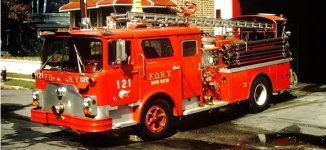- Joined
- Sep 25, 2013
- Messages
- 995
Second section companies, both engine and ladder companies, were originally established during the days of horse drawn apparatus to increase the availability of companies in high fire challenge areas of the city such as lower Manhattan. Both sections had the same response area but usually not the same incident. On any incident, one section would be assigned on the running cards. For a subsequent incident, the 2nd section would be available to respond. This doubled the company’s availability and minimized the need for numerous relocations. That is why early running cards did not show 2nd section companies – two section companies were simply capable of being at two separate incidents at the same time. The rare incidents that went above a 5th alarm, known as master alarms and simultaneous calls, could draw both sections of a company. In those incidents, the two-section fire company would usually be covered by one relocator.
2nd sections of the early motorized days were used to double the staffing and apparatus of companies in remote areas distant from other companies. Coney Island and Far Rockaway had 2nd section engine companies that became separate distinct units with their own numbers. Once they became separate units, each had their own first alarm district and running card assignments.
War years 2nd sections were assigned together but could easily find themselves at separate incidents when activity levels were high, the very reason why they were formed. A 2nd section at Engine 82 was established with its own identity (Engine 85). Initially assigned on the same alarms, they were given their own separate alarm assignments in an effort to maintain company availability in their area.
Most of the War Years 2nd section companies were reorganized as individual separate companies although not all remain in service to the present day.
2nd sections of the early motorized days were used to double the staffing and apparatus of companies in remote areas distant from other companies. Coney Island and Far Rockaway had 2nd section engine companies that became separate distinct units with their own numbers. Once they became separate units, each had their own first alarm district and running card assignments.
War years 2nd sections were assigned together but could easily find themselves at separate incidents when activity levels were high, the very reason why they were formed. A 2nd section at Engine 82 was established with its own identity (Engine 85). Initially assigned on the same alarms, they were given their own separate alarm assignments in an effort to maintain company availability in their area.
Most of the War Years 2nd section companies were reorganized as individual separate companies although not all remain in service to the present day.















